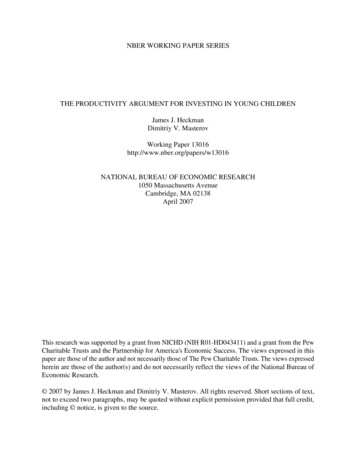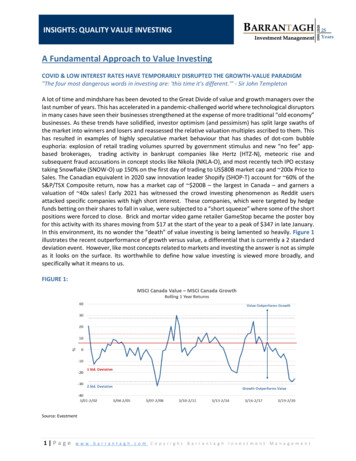
Transcription
NBER WORKING PAPER SERIESTHE PRODUCTIVITY ARGUMENT FOR INVESTING IN YOUNG CHILDRENJames J. HeckmanDimitriy V. MasterovWorking Paper 13016http://www.nber.org/papers/w13016NATIONAL BUREAU OF ECONOMIC RESEARCH1050 Massachusetts AvenueCambridge, MA 02138April 2007This research was supported by a grant from NICHD (NIH R01-HD043411) and a grant from the PewCharitable Trusts and the Partnership for America's Economic Success. The views expressed in thispaper are those of the author and not necessarily those of The Pew Charitable Trusts. The views expressedherein are those of the author(s) and do not necessarily reflect the views of the National Bureau ofEconomic Research. 2007 by James J. Heckman and Dimitriy V. Masterov. All rights reserved. Short sections of text,not to exceed two paragraphs, may be quoted without explicit permission provided that full credit,including notice, is given to the source.
The Productivity Argument for Investing in Young ChildrenJames J. Heckman and Dimitriy V. MasterovNBER Working Paper No. 13016April 2007JEL No. H52,I28ABSTRACTThis paper presents a productivity argument for investing in disadvantaged young children. For suchinvestment, there is no equity-efficiency tradeoff.James J. HeckmanDepartment of EconomicsThe University of Chicago1126 E. 59th StreetChicago, IL 60637and NBERjjh@uchicago.eduDimitriy V. MasterovDepartment of EconomicsUniversity of Michigan107 Lorch Hall611 Tappan StreetAnn Arbor, MI 48109-1220dvmaster@umich.edu
This paper presents the case for investing more in young American children who grow upin disadvantaged environments. Figure 1 graphs time series of alternative measures of thepercentage of children in disadvantaged families. The percentage of children born into, or livingin, nontraditional families has increased greatly in the last 30 years.1,2 Approximately 25% ofchildren are now born into single parent homes. While the percentages of children living inpoverty and born into poor families have fallen recently, they are still high, especially amongcertain subgroups.Adverse environments place children at risk for social and economic failure. The accidentof birth plays a powerful role in determining adult success.3 Many have commented on thisphenomenon, and most analyses have cast the issue of assisting children from disadvantagedfamilies as a question of fairness or social justice.This paper makes a different argument. We argue that, on productivity grounds, it makessense to invest in young children from disadvantaged environments. Substantial evidence showsthat these children are more likely to commit crime, have out-of-wedlock births and drop out ofschool. Early interventions that partially remediate the effects of adverse environments canreverse some of the harm of disadvantage and have a high economic return. They benefit not onlythe children themselves, but also their children, as well as society at large.Investing in disadvantaged young children is a rare public policy with no equityefficiency tradeoff. It reduces the inequality associated with the accident of birth and at the sametime raises the productivity of society at large.While a more rigorous analysis is necessary to obtain a better understanding of the effectsof early intervention programs, their precise channels of influence, and their exact benefits andcosts, the existing evidence is promising. An accumulating body of knowledge shows that early2
childhood interventions for disadvantaged young children are more effective than interventionsthat come later in life. Because of the dynamic nature of the skill formation process, remediatingthe effects of early disadvantages at later ages is often prohibitively costly (see Carneiro, Cunhaand Heckman and Cunha and Heckman, 2006). Skill begets skill; learning begets learning. Earlydisadvantage, if left untreated, leads to academic and social difficulties in later years. Advantagesaccumulate; so do disadvantages. A large body of evidence shows that post-school remediationprograms like public job training and General Educational Development (GED) certificationcannot compensate for a childhood of neglect for most people.This evidence has dramatic consequences for the way we think about policy toward skillformation. Most current policies directed towards improving the skills of youth focus on schoolsas the locus of intervention. The No Child Left Behind Act uses mandates and punishments toencourage schools to remediate the educational deficits of disadvantaged children. Schoolaccountability schemes are used to motivate higher levels of achievement for children fromdisadvantaged environments.While these initiatives are well-intentioned, their premise is faulty. Schools work withwhat parents give them. The 1966 Coleman Report on inequality in school achievement clearlydocumented that the major factor explaining the variation in the academic performance ofchildren across U.S. schools is the variation in parental environments—not the variation in perpupil expenditure across schools or pupil-teacher ratios. Successful schools build on the efforts ofsuccessful families. Failed schools deal in large part with children from dysfunctional familiesthat do not provide the enriched home environments enjoyed by middle class and upper middleclass children. Since failure in school is linked to so many social pathologies, each withsubstantial social and economic costs, a policy of equality of opportunity in access to homeenvironments (or their substitutes) is also a one that promotes productivity in schools, the3
workplace, and society at large.Rigorous statistical analysis is not needed to show that parents and their resources matter,although there is a large body of empirical evidence that supports this claim, as we documentbelow. The issue that has stymied social policy is how to compensate for adverse familyenvironments in the early years. One approach has been to reduce the material deprivationsuffered by the poor with transfers from the state, as in Lyndon Johnson’s War on Poverty.Another approach has been to bolster the family with programs outside the home. Sometimeschildren have been removed from the biological families, as in the case of the American Indiansin the early twentieth century. Policies that have removed children from homes have hadcatastrophic consequences.4An emerging body of evidence suggests that there is a better way to improve the earlyyears of disadvantaged children. Enriched preschool centers available to disadvantaged childrenon a voluntary basis coupled with home visitation programs have a strong track record ofpromoting achievement for disadvantaged children. The economic return to these programs ishigh, especially when we consider alternative policies that target children from disadvantagedenvironments or the policies targeted to the young adults who emerge from them. We review theevidence on these programs and suggest that some version of them be used to supplement theresources of disadvantaged families with children.Our logic is simple and compelling. Education and human skill are major factorsdetermining productivity, both in the workplace and in society. The family is a major producer ofthe skills and motivation required for producing successful students and workers. The mosteffective policy for improving the performance of schools is supplementing the childrearingresources of the disadvantaged families sending children to the schools. The family is a majordeterminant of child participation in crime and social deviance. A family supplementation policy4
is a successful anti-crime policy.Our emphasis on early childhood interventions does not deny the importance of schoolsor firms in producing human skill. Indeed, if proven early intervention programs are adopted,schools will be more effective, firms will have better workers to employ and train, and the prisonpopulation will decline. At lower cost to society, bolstered families will produce better educatedstudents, more trained workers and better citizens.This paper proceeds in the following way. We first discuss the problem of the supply ofskills to the American economy. Growth in both the quantity and the quality of the labor forcetraditionally has been a major source of U.S. output growth. Given current trends, U.S. growthprospects are poor. Labor force growth is slowing, especially that of young and skilled workerswho are a source of vitality for the entire economy. The composition of the future workforce willshift towards workers from relatively more dysfunctional families with commensurately worseskills.We next discuss the problem of crime in America. Even though the crime rate has fallenin recent years, the levels and costs of crime are still very high. The damage to victims and theresources spent on preventing crime and on incarcerating criminals are large. Early interventionprograms targeted towards disadvantaged families reduce participation in crime. On purelyeconomic grounds, the case for early childhood intervention is strong.After describing these two major social problems that impair the productivity ofAmerican society, we summarize trends in adverse child environments. We summarize a vastliterature in social science that establishes that dysfunctional and disadvantaged families aremajor producers of cognitive and behavioral deficits that lead to adverse teenage and adult socialand economic outcomes. The effects of disadvantage appear early and persist. Remediating thesedisadvantages at later ages is costly. Human abilities affect lifetime performance and are shaped5
early in the life of the child. Early interventions promote cumulative improvements. Enrichedinterventions targeted towards children in disadvantaged environments are cost-effectiveremedies for reducing crime and the factors that breed crime, and raising productivity in schoolsand in the workplace.We then move on to summarize the findings of the literature on the economics of childdevelopment that demonstrates the importance of both cognitive and noncognitive abilities inshaping child educational and economic outcomes. Both types of abilities are major determinantsof the economic return to education.Both cognitive and noncognitive abilities are shaped early in life and early differences inabilities persist. Gaps in college attendance across socioeconomic groups are largely shaped byabilities formed in the early years. Gaps in child ability across families of different income levelsare associated with parental environments and parenting practices. Early interventions canpartially remediate these deficits. Later interventions are much less effective. At current levels ofinvestment, American society over-invests in public job training and formal education and underinvests in early education for disadvantaged children.We summarize the evidence from a variety of early intervention programs targeted towarddisadvantaged children and focus on three early interventions that followed participants intoadulthood. Some of these interventions are evaluated by the method of random assignment. Earlyinterventions reduce crimes, promote high school graduation and college attendance, reducegrade repetition and special education costs, and help prevent teenage births. They raiseachievement as measured by test scores. Very early interventions also appear to raise IQ,especially for girls. Cost-benefit analyses of these programs reported in the literature show thatthey are cost effective. Estimated rates of return are 16%: 4% for participants and 12% forsociety at large. The paper concludes with a summary of the argument and some specific policy6
recommendations.Human Capital and Economic PerformanceEducation and skill are central to the performance of a modern economy. The emergenceof new technologies has raised the demand for highly skilled workers who are qualified to usethem. A wage premium for skilled labor emerged in many countries in the early 80s, and wageinequality grew as the economic return to education (the economic benefit of attending school)rose, especially in countries like the U.S. where the supply response to the increasing wagepremium was weak.5 Not only did the wages of the skilled rise, but those with the least abilityand education earn less today than comparable workers would have earned thirty years ago.Workforce TrendsTable 1, taken from Ellwood, highlights the problems facing the American labor marketin the next two decades. The first column of the table presents the distribution of the Americanworkforce among age and race-ethnicity categories in 1980. The second column shows thegrowth in the categories from 1980 to 2000 and the third column shows the labor force as of2000. The fourth column shows the projected growth in the labor force in the next twenty yearsby category. With the possible exception of the numbers for immigrants, these are reliableprojections because there is little emigration and the groups being projected are already alive.The immigration projections come from a carefully executed U.S. Census study. The labor forceis aging and young replacements for old workers are increasingly in short supply compared to the1980s.6 The aging of the American workforce raises serious problems for the future of Americanproductivity growth.The workforce of prime-age workers, fueled by the entry of Baby Boomers, propelled7
U.S. economic growth in 1980–2000. However, we cannot count on this source of growth in thenext twenty years. Indeed, the largest components of growth in the workforce will come fromolder workers as the Baby Boom cohort ages. Hence, a major source of vitality in the U.S.workforce will be lost. Future workforce growth will come from older workers and fromdemographic groups in which, for a variety of reasons, dysfunctional and disadvantaged familiesare more prevalent (See the middle rows of the table 1 and the discussion below).On top of these trends in the number of workers by age, there is stagnation in educationalattendance rates. Figure 2 shows the distribution of educational attainment among 30-year-oldsby year. College-going rates have stalled out for cohorts of Americans born after 1950. This isnot a consequence of immigration of unskilled workers. It is a phenomenon found among nativeborn Americans. Currently, 17% of all new high school credentials issued are GEDs.7 Heckmanand LaFontaine (2006) document that the high school dropout rate has increased over time if onecounts GEDs as dropouts, as one should, because GEDs earn the same wages as dropouts, andgraduate from college at the same rate as dropouts.The growth in the quality of the workforce, which was a mainstay of economic growthuntil recently, has diminished. Assuming that these trends continue, the U.S. economy will addmany fewer educated persons to the workforce in the next two decades than it did in the past twodecades (see table 2). Jorgenson, Ho, and Stiroh estimate that the average annual rate of growthof college labor supply was 4.5% in 1977, but fell to 1.75% in 1990–2000. These trends arepredicted to continue, or possibly worsen.The slowdown in labor force quality growth has already hurt American productivitygrowth. Delong, Katz, and Goldin estimate that increases in educational attainment boosted theeffective quality of the workforce by 0.5% a year over 1915–2000, and thus contributed anaverage of 0.35 percentage points per year to economic growth over that period.8 The slower8
growth in educational attainment of the workforce substantially reduced productivity growth inrecent years compared to its performance in the period 1915–1980. Based on current trends, theseauthors project that the annual rate of productivity growth attributable to education—0.35 from1980 through 2000—will decline by half or more (to between 0.17 and 0.06 percent) in the nexttwo decades. This will reduce the productivity growth of labor by a substantial 0.18–0.29percentage points per year and will be a drag on real wage growth and fiscal revenues.Literacy and NumeracyThe skills of the U.S. labor force are poor. The U.S. has a thick lower tail of essentiallyilliterate and innumerate persons, who are a drag on productivity and a source of social andeconomic problems. We use data from the International Adult Literacy Survey (IALS) toexamine literacy and numeracy of working age adults (age 16-65).9 Document literacy is definedas the ability to locate and use information from timetables, graphs, charts and forms. Figure 3presents data on document literacy. Tests for prose literacy and quantitative literacy produce thesame pattern.10Level 1 performance is essentially functional illiteracy or innumeracy. It represents theinability to determine the correct amount of medicine from information on a bottle of pills.People who perform at Level 1 can make limited use of texts that are simple and uncomplicated.They are only able to locate information in text or data as long as there is no distractinginformation around the correct answer. On the quantitative scale, they can only carry outrelatively straightforward operations such as simple addition. Roughly 20% of U.S. workers fallinto this category on each test, a much higher fraction than in some of the leading Europeancountries. This is a major drag on U.S. competitiveness11 and a source of social problems.9
CrimeCrime is a major burden on American society. Anderson (1999) estimates that the net costof crime (after netting out transfers) is over 1.3 trillion per year in 2004 dollars. The per capitacost is 4,818, in the same dollars. This figure includes crime-induced production (of personalprotection devices, trafficking of drugs and operation of correctional facilities) which costs 464billion per year; opportunity costs (production foregone by incarcerated offenders, valued at theirestimated wage, time spent locking and installing locks, and so forth) of 152 billion per year;and the value of risks to life and health (pain, suffering and mental distress associated with healthlosses) of 672 billion annually (table 3). This includes time lost from work by victims as well asvalue of life lost to murders. Some of these items like the valuation of life require controversialjudgments. Even ignoring any transfer component or any risks to life and health, the cost of crimeis over 600 billion per year. Although such calculations are necessarily imprecise and there isdisagreement over the exact costs, there is widespread agreement that the costs of crime aresubstantial.Even though crime rates have recently declined somewhat, their levels remain high (seefigure 4a). The adult correctional populations (in prison or local jail, on probation or on parole)continue to grow despite the drop in measured crime rates (see figure 4b). The size of thepopulation under correctional supervision has continued to increase for all groups, as has thepercentage of each group under supervision. Nine percent of blacks were under the supervision ofthe criminal justice system in some form in 1997, although recently this adverse trend hasslowed. Incarceration rates have risen steadily since 1980 and only slowed in the late 1990s. Theinmate population has risen steadily until recently.12 Expenditures on prisons, police and thejudicial system continue to grow despite the drop in measured crime rates (see figure 4c).These statistics do not convey the full scope of the problem. According to the Bureau of10
Justice Statistics (2004), as of the end of 2001, there were an estimated 5.6 million adults whohad ever served time in State or Federal prison--4.3 million former prisoners and 1.3 millionadults in prison. Nearly a third of former prisoners were still under correctional supervision,including 731,000 on parole, 437,000 on probation, and 166,000 in local jails. In 2001, anestimated 2.7% of adults in the U.S. had served time in prison, up from 1.8% in 1991 and 1.3% in1974. The prevalence of imprisonment in 2001 was higher for Black males (16.6%) and Hispanicmales (7.7%) than for White males (2.6%). It was also higher for Black females (1.7%) andHispanic females (0.7%) than White females (0.3%). Nearly two-thirds of the 3.8 millionincrease in the number of adults ever incarcerated between 1974 and 2001 occurred as a result ofan increase in first incarceration rates; one-third occurred as a result of an increase in the numberof residents age 18 and older. If recent incarceration rates remain unchanged, an estimated one ofevery 15 persons (6.6%) will serve time in a prison during his or her lifetime.The lifetime chances of a person going to prison are higher for men (11.3%) than women(1.8%), and for Blacks (18.6%) and Hispanics (10%) than Whites (3.4%). Based on current ratesof first incarceration, an estimated 32% of black males will enter state or federal prison duringtheir lifetime, compared to 17% of Hispanic males and 5.9% of White males.What Can We Do about This Problem?It is now well established that education reduces crime. Figure 5, from Lochner andMoretti, displays this relationship, reported separately for blacks and whites. Increasing highschool graduation rates is a major crime prevention strategy. Risk factors promoting crimeinclude poor family backgrounds, which also promote high school drop out. Poorly educatedteenage mothers in low-income families are much more likely to produce children whoparticipate in crime.13 We discuss the evidence on the impact of family background on child11
participation in crime in the next section. Although analysts do not agree on which specificaspects of adverse family environments most affect crime, they all agree that there is a strongempirical relationship between early adverse environments and child participation in crime lateron in life.Some of the most convincing estimates of the impact of adverse early environments onparticipation in crime come from interventions designed to remedy those environments. Table 4presents a summary of the impacts of a variety of early childhood intervention programs onparticipation in crime. We discuss some of these programs in much greater detail in below. Herewe summarize some findings relevant to crime.Many of these programs were evaluated by the method of random assignment. Childrenfrom disadvantaged populations were randomly assigned, at early ages, to the enriched childdevelopment programs described in the third column of the table. Most interventions were forchildren in the pre-kindergarten years. Both the experimental treatment group and the controlswere followed over time, often for many years after the intervention. The Perry Preschoolprogram, which we discuss in detail below, followed the intervention and control children formore than 30 years after the intervention. Over that time, the Perry students averagedsignificantly fewer lifetime arrests than the comparison group, including arrests for dealing andproducing drugs. This effect was especially pronounced for males. The Abecedarian programappears to be anomalous, because it did not reduce crime in the treatment group compared to thecontrol group. It was administered to a population in a low-crime region in the South. Moststudies show dramatic reductions in criminality and participation in the criminal justice systemfor treatment group members. Enriched environments reduce crime. Impoverished environmentspromote crime.Lochner and Moretti present convincing non-experimental evidence that increasing12
educational attainment reduces crime and that the inverse relationship between crime andeducation in figure 5 is not a correlational artifact arising from unobserved variables that arecommon to both crime and education. Using Census data, they show that one more year ofschooling reduces the probability of incarceration by 0.37 percentage points for blacks, and 0.1for whites.14 To put this evidence in perspective, 23% of the black-white difference in averageincarceration rates can be explained by the differences in education between these groups. Usingthe FBI’s Uniform Crime Reports, they find that the greatest impacts of education are associatedwith reducing arrests for murder, assault, and motor vehicle theft.Lochner and Moretti also calculate the social savings from crime reduction associatedwith completing secondary education. They show that a 1% increase in the high schoolgraduation rate would yield 1.8 billion dollars in social benefits in 2004 dollars. This increasewould reduce the number of crimes by more than 94,000 each year (see table 5). The socialbenefits include reduced losses in productivity and wages, lower medical costs, and smallerquality-of-life reductions stemming from crime.15 They also include reductions in costs ofincarceration.16High school graduation confers an extra benefit of 14-26% beyond private returnscaptured by the high school graduate wages that are pocketed by graduates. This is an importantbenefit of education beyond its private return that suggests overall under-investment in thepopulation of disadvantaged children at risk for committing crime. Completing high school raisesa student’s wages by about 10,372 per year (in 2004 dollars), and the direct cost of completingone year of secondary school is approximately 8,000 per student in 1997 (in 2004 dollars).Looking only at the savings from reduced crime, the return is 1,638- 2,967 per year, so thatexpenditure is cost effective even if we ignore the direct benefits in earnings and even if weassume that the benefits decline as the youths grow older.13
Comparing the effect of educational expenditure with the effect of hiring an additionalpolice officer suggests that promoting education may be a better strategy. Using a somewhatdifferent framework, Levitt claims that an additional sworn police officer in a large U.S. citywould reduce annual costs from crime by about 200,000 dollars at a public cost of 80,000 peryear. These are recurrent annual costs.Lochner and Moretti estimate that in steady state it would cost 15,000 per year in termsof direct costs to produce enough high school graduates to reduce crime by the same amount.This cost ignores foregone earnings in high school but it also ignores all of the benefits from highschool graduation documented in Heckman, Lochner, and Todd. If Levitt’s estimate is correct,educational policy is far more effective per dollar spent than expenditure on police.17,18Trends in Children’s Home Environments and the Consequences of Adverse EnvironmentsDemographers have documented that over the past forty years, the aggregate birth rate hasdeclined, but in the past few decades relatively more of all American children born are born intoadverse environments. The definition of adversity varies among studies, but the measures usedare strongly interrelated. Most scholars recognize that absence of a father, low levels of financialresources, low parental education and ability, a lack of cognitive and emotional stimulation, andpoor parenting skills are characteristics of adverse environments. Determining the relativeimportance of these factors is an ongoing debate. Each seems to play a factor in affecting childoutcomes.Family StructureFewer children are living with two parents who are married. In 2003, 68% of children14
under 18 lived with two married parents, down from 77% in 1980.19 This percentage hasremained stable since 1995, after trending downward for many years. The percentage of childrenwho live with only one parent, or in a home where the parents are not married, increased by 8%since 1980 to 28%. The percentage of children who live with no parents remained roughlyconstant around 3-4% during this period. The source of single parenthood has also changed.Relatively more children are living with a single parent who has never been married (see figure6a).The aggregate trends conceal a great deal of variation across demographic groups. In2003, 77% of non-Hispanic White children lived with two married parents, while 20% lived withonly one parent or with unmarried parents. The corresponding percentages for Blacks were 36%and 56%. For Hispanics, it was 65% and 31%.20 Among Blacks, the percentage of childrenliving with a never-married parent has increased dramatically over time.21Non-Marital ChildbearingSince the 1965 Moynihan Report, many analysts have focused on family structure—theabsence of a parent and the attendant decline in financial, emotional and cognitive resources—asan important source of social problems.22 Over time, while the birth rate has fallen, births tounmarried women have risen until very recently.After rising dramatically since 1940, out-of-wedlock childbearing leveled off in the 1990sbut remains at a very high level.23 The number of births to unmarried women increased from1.17 to 1.3 million between 1990 and 1999. The birthrate for unmarried women increased from43.8 births per 1,000 unmarried women aged 15-44 years in 1990 to 46.9 in 1994, before fallingback to 43.9 in 1999.24 The percentage of all births to unmarried women has risen from 28% in1990 to 33% in 1999, though it has been roughly constant at 32-33% since 1994. To put these15
numbers in perspective, in 1940, this number was 3.8%.The birth rate for unmarried Black women has been higher than that of White unmarriedwomen (including Hispanic women), but this gap has narrowed in recent years because the birthrate has grown at a faster pace for unmarried White women.25 In 1970, the rate for unmarriedBlack women was roughly 7 times the rate for unmarried White women—96 per 1,000 versus 14per 1,000. By 1998, the gap was reduced by 70%; it became 73 versus 38 per 1,000.Unfortunately, the birthrate for unmarried Hispanic women is only available for the1990s, but it is the highest among the three demographic groups. In 1990, the birthrate forunmarried Hispanic women was 89.6 per 1,000, peaked at 101.2 per 1,000, and fell to 90.1 per1,000 in 1998.26The
The percentage of children born into, or living in, nontraditional families has increased greatly in the last 30 years.1,2 Approximately 25% of children are now born into single parent homes. While the percentages of children living in . Investing in disadvantaged young children is a rare










